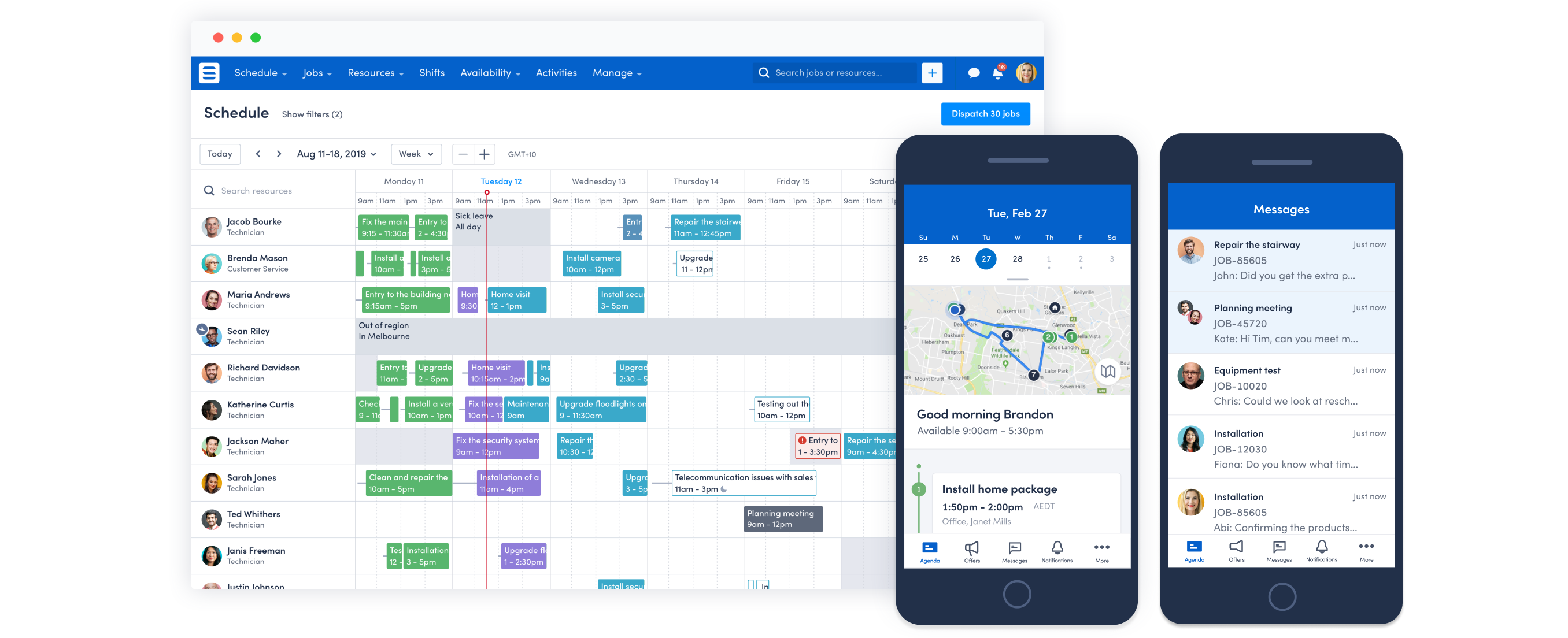6 Ways Digital Transformation Can Truly Support Your Deskless Workforce
It’s no secret that digital transformation has been an ongoing effort for many companies for several years. Organizations have realized the benefits of shifting to digitally-minded business processes, tools, and cultures, along with the risks of failing to adapt.
More recently, the COVID-19 pandemic has highlighted just how much of a necessity digital transformation is for companies as they adjust to new ways of conducting business. But still, so many digital transformation strategies focus on in-office workers and fail to address the challenges that deskless workers continue to face—like a lack of real-time visibility, limited or disparate tools, poor communication, and more.
We know that digitally-driven businesses are 26% more profitable than their less adaptive counterparts, regardless of the industry in which they operate. So why is it that organizations have continued to ignore the advantages of such initiatives as they specifically relate to mobile workers?
To fully empower your deskless workforce and reap all the benefits digital transformation has to offer, you need a strategy (and robust tools that support that strategy) that’s built with the nuances of mobile work in mind.
What is Digital Transformation?
Digital transformation is the practice of implementing digital technologies into every part of a business operation; from sales, to marketing, to IT, to finance, to the mobile workforce. It’s important to note that digital tool integration alone will not suffice as a viable transformation initiative. Organizations must also leverage key processes, integrate their systems, and shift to a digitally-driven company culture, too.
Your digital transformation strategy should be tailored to your unique business needs, requirements, and objectives. No two strategies are exactly alike, but—at the core—digital transformation for a deskless workforce should focus on making meaningful improvements to processes and tools to better support your employees and your organization as a whole.
As businesses with a deskless or blended workforce develop their digital transformation strategies, they should prioritize some crucial best practices in order to empower their employees—who can, in turn, better serve their customers and boost their bottom line.
1. Enable Frontline Data Collection
A crucial part of any successful mobile workforce operation is a strong process for data collection, and proper digital transformation makes it easier than ever. But gathering field data can be difficult if your deskless workers don’t have the right tools to capture information when and where they need to. They often rely on paper forms or disconnected tools to collect customer notes and signatures, which is both time-consuming and error-prone. Plus, they must then spend time entering that information into a central system back at the office at the end of the day; a process that’s repetitive, tedious, and risky in terms of data lossage.
For improved accuracy, your deskless workers should have powerful tools that enable them to collect all of these details on site. Some mobile data collection tools even work offline, then automatically sync information back to the system when connectivity is restored, so nothing falls through the cracks.
The case for an improved documentation process is clear: A deskless workforce that’s backed by secure, real-time data is more productive, efficient, and prepared. Mobile workers always arrive ready to complete the job, with seamless access to customer and job information to help along the way. Customers don’t have to repeat their issues or details to multiple employees, as everyone can easily see job history, customer preferences, and other key information.
Armed with the right technology for capturing and retrieving field data, your deskless workers can stay on track with each job. They no longer have to task-switch or toggle between apps to find disparate information. And they can save the time they’d otherwise spend translating piles of paper into systems at the end of the day.
Frontline data collection also increases the efficiency of desk-based workers. Schedulers, dispatchers, and AP/AR team members can easily schedule follow-up appointments or send invoices with full confidence in the accuracy of the information they’re using.
2. Encourage Real-time Communication
Communication has typically been a giant barrier for mobile and blended teams. They often have to switch between multiple tools (e.g. text messages, emails, phone calls, Slack, etc.) to send and receive updates, which is frustrating, time-intensive, and riddled with issues in miscommunication.
By investing in real-time communication tools as part of your larger digital transformation strategy, you can ensure both back-office employees and deskless workers are always on the same page. Field workers can access up-to-date schedules with a mobile app that centralizes all communications and alerts in a single place. They can instantly communicate with managers or team members when an issue arises (e.g. real-time troubleshooting or situation management), which improves on-the-job safety, connectedness, and collaboration.
Deskless workers can also easily reach schedulers and dispatchers when there’s an unexpected delay or circumstance. This empowers schedulers and dispatchers to truly support their deskless colleagues: When they receive a last-minute update, they can reach out to customers who are affected by a delay, or start looking for another qualified worker to complete the job.
3. Centralize Important Information in One Place
Field data isn’t the only essential piece of the information puzzle for your mobile workforce. Deskless and desk-based workers need quick and easy access to training resources, policy documents, broader company news, and more. In an attempt to accelerate their transformation initiatives and store more vital information, some businesses have simply adopted a variety of shiny new tools that promise innovation. But if these tools operate as disconnected systems, your employees are likely wasting time hunting down valuable information.
Adopting a digital approach means eliminating the silos across your tech stack to drive efficiency, preparation, and more informed decision making. By fully integrating your existing systems, employees gain a centralized source of truth with everything they need to be successful. Deskless workers arrive at each appointment with all the relevant information at their fingertips, so they can get the job done right the first time. Customers are met with fully prepared workers who are ready to deliver exceptional service.
Digital records that are stored and accessible in a single place also means your back-office and deskless workers save time on manual paperwork and re-entering data into multiple systems. Your entire operation becomes more efficient, and your employees can record and retrieve everything they need without the frustration of digging through multiple tools to find it. The result is a more productive, satisfied workforce; and thus a better-served client base.
4. Forecast Staffing Needs
A common headache among organizations with a deskless workforce is the inability to properly plan for staffing needs. Customer demand fluctuates, and businesses find themselves over- or under-staffed, leading to either underutilized employees or overworked team members who are at risk for premature burnout.
Workforce visibility is the solution to this issue, and it requires data around your employees (skill sets, experience, training), their location (current and where they’re traveling to next), and historical information (periods of high and low customer demand). Digital transformation that’s grounded in supporting a mobile workforce means using powerful tools that help your business gain a holistic view of each of these aspects.
With the right tool, your business can integrate all of your crucial data in one place, so you can identify (in advance!) when you need more staff coverage for a given event or season, based on previous demand. That kind of foresight means fewer instances of being short-staffed, and therefore less burnout; helping you avoid costly turnover.
Some tools enable you to generate robust reports that help you understand and forecast capacity against demand, so each deskless worker is fully utilized. This leads to greater employee satisfaction—as everyone wants to feel their time is well-spent and that their skills are being used—and an enhanced ability to serve more customers, as needed.
5. Use Analytics for Continuous Improvement
As the realities of the pandemic set in, many mobile workforce organizations began to embark on a digital transformation journey to remain competitive and adequately serve their customers. But some have abandoned their strategies after their initial implementation, and the success of their workforce has suffered as a result.
It’s crucial to remember that digital transformation is a process, not a one-and-done fix that ends once you’ve deployed your new tools. If fully empowering your mobile workforce is your goal (and it should be!), make sure you review your strategy on an ongoing basis. Re-evaluate your KPIs—for each department or role—consistently to find where things are going well and where there are opportunities to improve. Match those KPIs to specific company priorities and measure them against actual performance. Whether it’s utilization, rework percentage, schedule adherence, or simply jobs completed per week, identify your metrics, track them on a set cadence, and take action on the results.
The tools you use should help you along the way. Make sure your solution enables you to track KPIs, identify inefficiencies or productivity gaps, spot opportunities to optimize schedules, and determine areas where you can cross-sell or upsell services.
6. Find (and Customize!) the Right Solution
Far too often, organizations adopt tools that simply aren’t the right fit for their specific needs. Many businesses implement solutions that are built for the desk-based workforce, then adapt them to meet the needs of their deskless workers. But this approach leaves mobile workers wanting more, as they don’t support their unique requirements for real-time communication, flexible scheduling, accessible resources, or streamlined data collection.
As you build out your digital transformation strategy, look for solutions (and integrations) that specifically set your deskless workers up for success, rather than those that treat them as an afterthought. The right solution should be able to be tailored to meet your deskless workforce’s distinct needs, including:
- Intelligent scheduling and dispatching (based on qualifications, preferences, locations, etc.)
- Optimized routing
- Mobile field data collection
- Seamless integration with existing systems
- Real-time communication
- Transparency into day-to-day operations
Solutions that are purposely built with a deskless workforce in mind also reduce the security risks often associated with mobile work. The more platforms and access points you have, the more at-risk you are for data breaches, malware attacks, and more. The right tool should enable you to easily develop robust security policies—including establishing tiered access and permission settings, requiring digital certifications, device enrollment, and authentication. Deskless workers, then, have everything they need without sacrificing the security of company and customer data.
Digitally Transform Your Mobile Workforce with Deskless Productivity Software
Successful digital transformation for a deskless workforce means optimizing your tools and processes to better support the needs of your employees and your customers. When your transformation approach is built with your mobile workers in mind, you drive productivity and employee satisfaction; helping you retain the skilled workers who are so valuable to your business.
Skedulo’s deskless productivity software is specifically designed for deskless workers. It offers powerful technology to help you improve worker safety, with tools for better communication, enhanced digital access to processes, and seamless integrations.
Learn more about how your business can drive its digital transformation efforts to improve employee and customer satisfaction (and boost revenue), or book a demo today.




